day07 Cookie 和 Session(非常重要)
Posted Spurs
tags:
篇首语:本文由小常识网(cha138.com)小编为大家整理,主要介绍了day07 Cookie 和 Session(非常重要)相关的知识,希望对你有一定的参考价值。
- day07 Cookie 和 Session
- 1. 会话技术
- 2. cookie 的方法和 cookie 案例-显示用户上次访问网站的时间
- 3. cookie 的细节 - 删除 cookie
- 4. Session 对象
- 5. 用户禁用了 cookie,session就不好使了,做电商网站的要解决这个问题,解决方案为:URL 重写
- 6. session 细节:IE7 和 IE8以上浏览器在session上的不同表现
- 7. session - 简单的购物案例(一定要看看)
- 8. 利用 session 完成用户登陆
- 9. 客户端防表单重复提交和服务器端 session 防表单重复提交 - 涉及 Base64Encoder,令牌发生器,单例设计模式
- 10. 利用session校验图片认证码
- 11. 三个域对象的总结 - request, session 和 servletContext 这三个域,分别应该啥时候用?
Author:相忠良
Email: ugoood@163.com
起始于:April 23, 2018
最后更新日期:April 26, 2018
声明:本笔记依据传智播客方立勋老师 Java Web 的授课视频内容记录而成,中间加入了自己的理解。本笔记目的是强化自己学习所用。若有疏漏或不当之处,请在评论区指出。谢谢。
涉及的图片,文档写完后,一次性更新。
day07 Cookie 和 Session
直觉上:Cookie 和 Session 只为1次会话(简单的说:打开浏览器访问网站--关闭访问那个网站的浏览器,这叫会话)而服务。
1. 会话技术
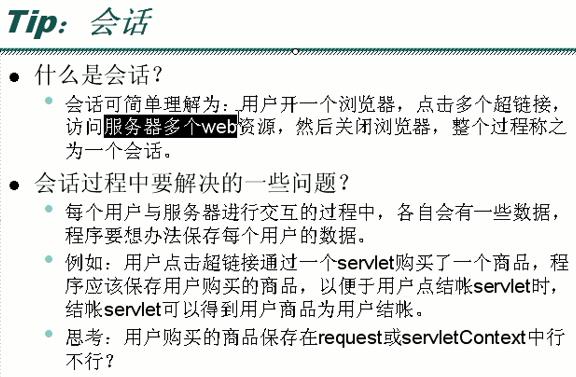
用户购买的商品保存在 request 或 servletContext 中是不行的。
每次请求有1个request, servletContext 保存的是全局性内容,所以不可以。
day07 中讲的内容就是如何保存每位用户的数据。保存用户数据有两种方案:

Cookie 是客户端的技术:
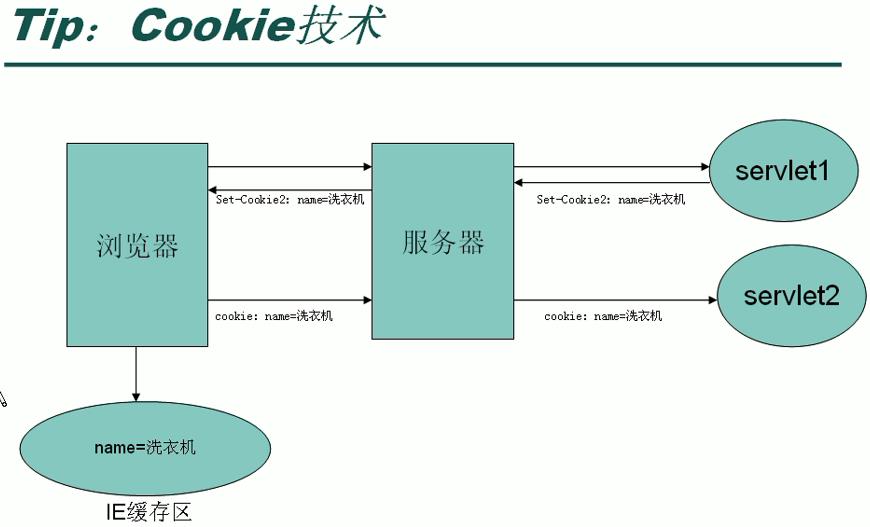
Session 是服务器端的技术:
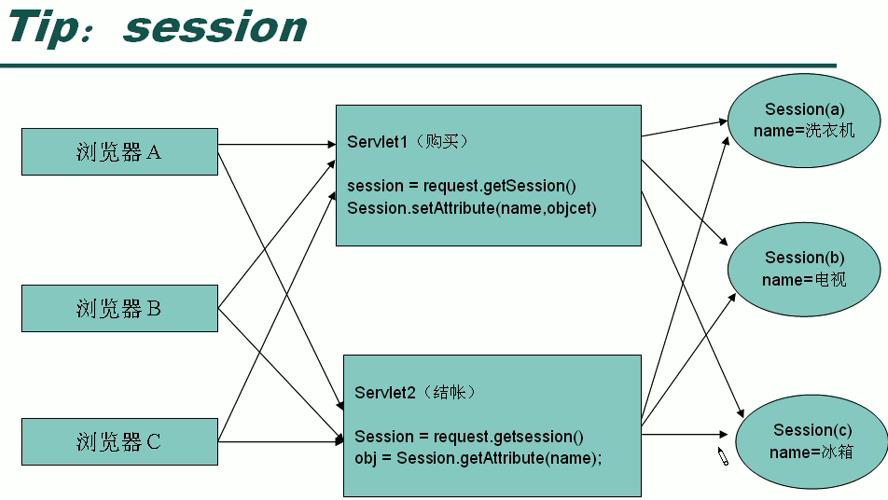
2. cookie 的方法和 cookie 案例-显示用户上次访问网站的时间
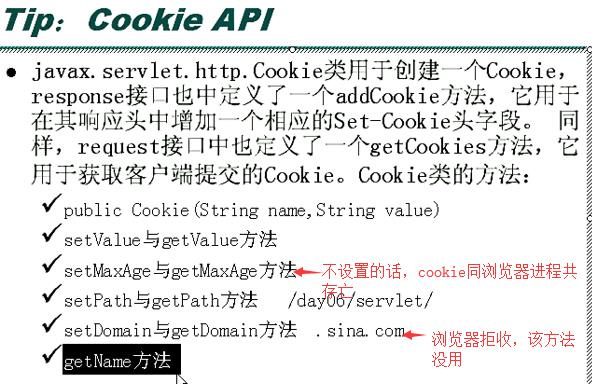
cookie应用:显示客户上次访问时间
道理:上次访问网站时,网站写cookie送给浏览器存下来,本次访问同一个网站时,浏览器就带着cookie去,传递了上次访问时间的数据。新建 day07 的 web 工程,做如下实验:
// 代表网站首页
public class CookieDemo1 extends HttpServlet {
public void doGet(HttpServletRequest request, HttpServletResponse response)
throws ServletException, IOException {
response.setCharacterEncoding("UTF-8");
response.setContentType("text/html;charset=UTF-8");
PrintWriter out = response.getWriter();
out.print("您上次访问的时间是:");
// 获取用户的时间 cookie
Cookie[] cookies = request.getCookies();
for (int i = 0; cookies != null && i < cookies.length; i++) {
if (cookies[i].getName().equals("lassAccessTime")) {
long cookieValue = Long.parseLong(cookies[i].getValue()); // ms 得到用户的上次访问时间
Date date = new Date(cookieValue);
out.print(date.toLocaleString()); // 转换成本地习惯的日期
}
}
// 给用户回送最新的访问时间
Cookie cookie = new Cookie("lassAccessTime", System.currentTimeMillis()
+ "");
cookie.setMaxAge(1 * 30 * 24 * 3600); // 设置有效期 秒 -- 1个月
cookie.setPath("/day07"); // 设置该cookie适用范围
response.addCookie(cookie);
}
}
3. cookie 的细节 - 删除 cookie
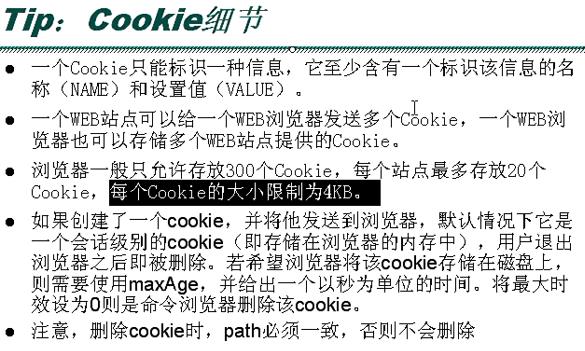
本案例涉及2个文件。故事是记录并显示上次访问时间,点击清除超链接,清除上次访问时间,如下:
注意:设置相同的 cookie 的名字和 path,才能删除 cookie,可参考CookieDemo2的代码。
// 代表网站首页
public class CookieDemo1 extends HttpServlet {
public void doGet(HttpServletRequest request, HttpServletResponse response)
throws ServletException, IOException {
response.setCharacterEncoding("UTF-8");
response.setContentType("text/html;charset=UTF-8");
PrintWriter out = response.getWriter();
out.print("<a href=\'/day07/servlet/CookieDemo2\'>清除上次访问时间</a><br/>");
out.print("您上次访问的时间是:");
// 获取用户的时间 cookie
Cookie[] cookies = request.getCookies();
for (int i = 0; cookies != null && i < cookies.length; i++) {
if (cookies[i].getName().equals("lassAccessTime")) {
long cookieValue = Long.parseLong(cookies[i].getValue()); // ms
// 得到用户的上次访问时间
Date date = new Date(cookieValue);
out.print(date.toLocaleString()); // 转换成本地习惯的日期
}
}
// 给用户回送最新的访问时间
Cookie cookie = new Cookie("lassAccessTime", System.currentTimeMillis()
+ "");
cookie.setMaxAge(1 * 30 * 24 * 3600); // 设置有效期 秒 -- 1个月
cookie.setPath("/day07"); // 设置该cookie适用范围
response.addCookie(cookie);
}
public void doPost(HttpServletRequest request, HttpServletResponse response)
throws ServletException, IOException {
doGet(request, response);
}
}
public class CookieDemo2 extends HttpServlet {
// 清除 cookie
public void doGet(HttpServletRequest request, HttpServletResponse response)
throws ServletException, IOException {
Cookie cookie = new Cookie("lassAccessTime", "");
cookie.setMaxAge(0);
cookie.setPath("/day07");
response.addCookie(cookie);
response.sendRedirect("/day07/servlet/CookieDemo1");
}
public void doPost(HttpServletRequest request, HttpServletResponse response)
throws ServletException, IOException {
doGet(request, response);
}
}
浏览器输入http://localhost:8080/day07/servlet/CookieDemo1查看结果。
4. Session 对象

Cookie 和 Session 只为1次会话(简单的说:打开浏览器访问网站--关闭访问那个网站的浏览器,这叫会话)而服务。可从下面的例子验证。
案例: 购买和结账,涉及3个文件如下:
首页:
<%@ page language="java" import="java.util.*" pageEncoding="UTF-8"%>
<!DOCTYPE HTML PUBLIC "-//W3C//DTD HTML 4.01 Transitional//EN">
<html>
<head>
<title>My JSP \'index.jsp\' starting page</title>
</head>
<body>
<a href="/day07/servlet/SessionDemo1">购买</a>
<a href="/day07/servlet/SessionDemo2">结账</a>
</body>
</html>
购买处理:
// 购买
public class SessionDemo1 extends HttpServlet {
public void doGet(HttpServletRequest request, HttpServletResponse response)
throws ServletException, IOException {
HttpSession session = request.getSession(); // 创建或获取session
session.setAttribute("name", "洗衣机");
}
}
结账处理:
// 结账
public class SessionDemo2 extends HttpServlet {
public void doGet(HttpServletRequest request, HttpServletResponse response)
throws ServletException, IOException {
// 以后用 filter 解决网站乱码问题
response.setCharacterEncoding("UTF-8");
response.setContentType("text/html;charset=UTF-8");
PrintWriter out = response.getWriter();
HttpSession session = request.getSession(false); //只获取session
String product = (String) session.getAttribute("name");
out.write("您购买的商品是:" + product);
}
}
浏览器中输入http://localhost:8080/day07/index.jsp查看结果。
上述例子并未达到方立勋老师所说的效果。我开启2个浏览器页面,一个点购买,另一个浏览器点结账,仍可收到session信息。
但若开启1个谷歌,1个IE,则试验成功。
4.1 配置 session 存活时间
创建 session 的时机:客户访问到getSession()方法时, 服务器就创建 session。
session 销毁的时机: 30分钟没人用这个 session 了,session 将被销毁,即使会话不关。
2种方式:web.xml 配置方式 和 代码方式。
web.xml 文件加入如下配置(存活10分钟,默认30分钟):
<session-config>
<session-timeout>10</session-timeout>
</session-config>
代码方式:
摧毁session: 在 SessionDemo1 中加入 session.invalidate();
不创建,只获取session:正常的行为:“用户第一次访问getSession()就创建session,第2次访问时就不创建session而只获取session。” 但request.getSession(false);的执行会导致永远不创建session, 而只获取session。
4.2 session 工作原理(基于 cookie,且无有效期,即浏览器关掉 cookie 就消失)
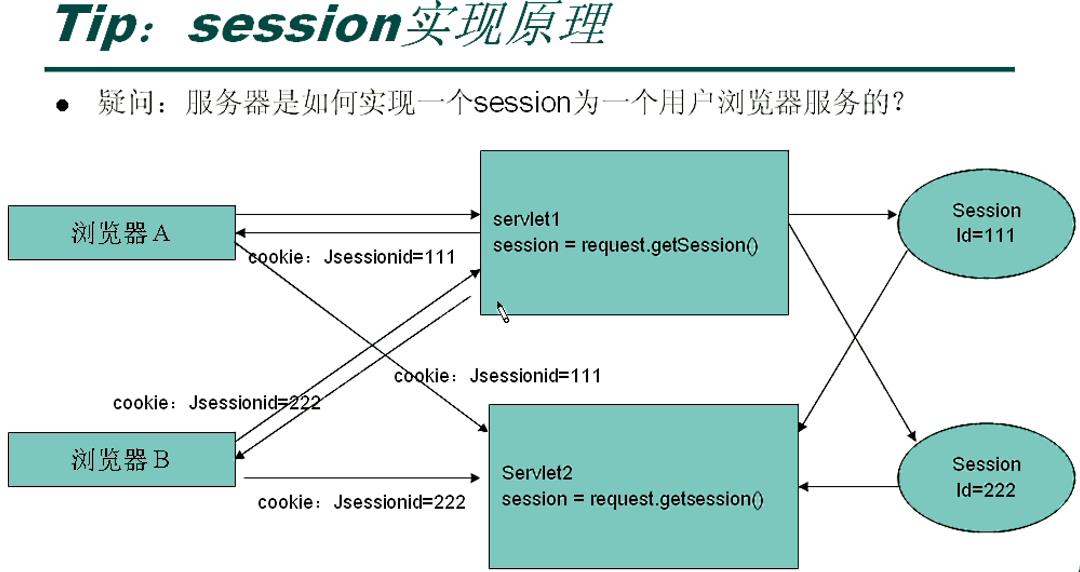
故事:想实现关掉浏览器(关会话)后,重新登录,也能看到所购买的商品。
原理分析:getSession()创建一个session时,还生成了一个cookie,这个cookie里包含了当前会话session的id,既JSESSIONID,并通过response写回给客户机浏览器,但没设定setMaxAge(),意味着关闭浏览器后这个cookie就消失了,所以重新登录后,浏览器就不会带着名为JSESSIONID的cookie找服务器,这样服务器就无法通过id号找到存放在服务器内的对应的session,故而无法找到客户原来买的东西了。
解决办法:重写名为JSESSIONID的cookie,设置其路径,设置其MaxAge,代码如下:
// 购买
public class SessionDemo1 extends HttpServlet {
public void doGet(HttpServletRequest request, HttpServletResponse response)
throws ServletException, IOException {
HttpSession session = request.getSession();
// 覆盖 getSession 时创建的 cookie(里面包含 id)
String sessionid = session.getId();
Cookie cookie = new Cookie("JSESSIONID", sessionid);
cookie.setPath("/day07");
cookie.setMaxAge(30 * 60);
response.addCookie(cookie);
session.setAttribute("name", "洗衣机");
// session.invalidate(); // 摧毁 session
}
}
结果就是:打开一个浏览器“购买”,关闭该浏览器,半小时内再开这个浏览器的话,仍然能“结账”,既上一个浏览器购买的商品还在。
5. 用户禁用了 cookie,session就不好使了,做电商网站的要解决这个问题,解决方案为:URL 重写
浏览器禁用cookie的操作:工具 -> Internet选项 -> 隐私 -> 高级 -> 替代自动 cookie 处理 -> 阻止第一方和第三方 cookie
本实验需将localhost(浏览器不阻止localhost)改成127.0.0.1才行, 如浏览器地址改为http://127.0.0.1:8080/day07/index.jsp。禁用 cookie 后,session 就不起作用了。
解决方案为:URL 重写
不同用户点击首页的超链接时,超链接里弄上 session 的 id 号。用户点超链接时,这个 session 的 id 号通过超链接传送给服务器。
重写 URL,新做一个 WelcomeSession 模拟首页,里面带了response.encodeURL(),它能自动把用户 session id 写入指定的 URL。下面代码能做到当用户禁用cookie时,通过超链接携带 session id 的功能。代码如下:
public class WelcomeSession extends HttpServlet {
public void doGet(HttpServletRequest request, HttpServletResponse response)
throws ServletException, IOException {
response.setCharacterEncoding("UTF-8");
response.setContentType("text/html;charset=UTF-8");
PrintWriter out = response.getWriter();
request.getSession();
// 10个人访问相同的代码,但有10个不同的 session,超链接里就有10个不同的 session id
// 在 URL 后面加 session id
String url1 = response.encodeURL("/day07/servlet/SessionDemo1");
String url2 = response.encodeURL("/day07/servlet/SessionDemo2");
out.print("<a href=\'" + url1 + "\'>购买</a><br/>");
out.print("<a href=\'" + url2 + "\'>结账</a>");
}
浏览器输入http://localhost:8080/day07/servlet/WelcomeSession点击购买,结账,结账时仍然能显示洗衣机。
6. session 细节:IE7 和 IE8以上浏览器在session上的不同表现
同一个session的情形:
- 开启浏览器,又开启一个新的选项卡窗口;
- 同一个浏览器,点开一个超链接窗口。
只有手动开启2个浏览器时(IE7),会有不同的session。IE8以后的浏览器即使开2个浏览器,默认还是同一个session。我现在的机器就是这种情况(我的是IE11)。方老师为了讲课用的是IE7。
7. session - 简单的购物案例(一定要看看)
这个购物案例,我们在 cn.wk.shopping 包中建立 servlet 程序。
此案例涉及3个servlet程序:
- ListBookServlet 首页,列出所有书;
- BuyServlet 完成购买(购物车);
- ListCartServlet 显示用户已购买的商品。
代码如下( 通过 session 一个劲滴传递购书信息,里面还涉及了用户禁用cookie后的处理,即 URL 重定向 ):
// 代表网站首页,列出所有书
public class ListBookServlet extends HttpServlet {
@Override
public void doGet(HttpServletRequest request, HttpServletResponse response)
throws ServletException, IOException {
response.setCharacterEncoding("UTF-8");
response.setContentType("text/html;charset=UTF-8");
PrintWriter out = response.getWriter();
request.getSession();
out.print("本网站有如下商品:<br/>");
Map<String, Book> map = Db.getAll();
for (Map.Entry<String, Book> entry : map.entrySet()) {
Book book = entry.getValue();
String url = response.encodeURL("/day07/servlet/BuyServlet?id="
+ book.getId());
// 正常情况下,输出时,这里通常要跳到 jsp,然后美化,本案例先不这样做了
// target=\'_blank\' 打开新窗口
out.print(book.getName() + "<a href=\'" + url
+ "\' target=\'_blank\'>购买</a><br/>");
}
}
@Override
public void doPost(HttpServletRequest request, HttpServletResponse response)
throws ServletException, IOException {
doGet(request, response);
}
}
// 模拟数据库
class Db {
private static Map<String, Book> map = new LinkedHashMap<String, Book>();
static {
map.put("1", new Book("1", "JavaWeb 开发", "老张", 39));
map.put("2", new Book("2", "JDBC 开发", "老黎", 39));
map.put("3", new Book("3", "Spring 开发", "老张", 39));
map.put("4", new Book("4", "Hibernate 开发", "老方", 39));
map.put("5", new Book("5", "Ajax 开发", "老毕", 39));
}
public static Map<String, Book> getAll() {
return map;
}
}
// bean
class Book implements Serializable {
private String id;
private String name;
private String author;
private double price;
public Book() {
super();
}
public Book(String id, String name, String author, double price) {
super();
this.id = id;
this.name = name;
this.author = author;
this.price = price;
}
public String getId() {
return id;
}
public void setId(String id) {
this.id = id;
}
public String getName() {
return name;
}
public void setName(String name) {
this.name = name;
}
public String getAuthor() {
return author;
}
public void setAuthor(String author) {
this.author = author;
}
public double getPrice() {
return price;
}
public void setPrice(double price) {
this.price = price;
}
}
// 完成购买
public class BuyServlet extends HttpServlet {
@Override
public void doGet(HttpServletRequest request, HttpServletResponse response)
throws ServletException, IOException {
String id = request.getParameter("id");
Book book = Db.getAll().get(id);
// 保存用户买的书,一会“结账”时用
HttpSession session = request.getSession(false);
/*
* 1. 手工以cookie形式发sessionid,以解决关闭浏览器后,上次买的东西还在(未解决)
*
* 2. 若用户关闭cookie,要用 URL
* 重写方式(需在ListBookServlet首页中就得创建session),重写所有超链接(方老师已解决)
*/
// 从session得到用户用于保存所有书的集合(购物车)
List list = (List) session.getAttribute("list");
if (list == null) {
list = new ArrayList();
session.setAttribute("list", list);
}
list.add(book);
/*
* request.getRequestDispatcher("/servlet/ListCartServlet").forward(
* request, response); // 不能转发,浏览器刷新时会把上次干的事重新干一次
*/
// 用重定向跳到购物车
// request.getContextPath() = /day07
String url = response.encodeRedirectURL(request.getContextPath()
+ "/servlet/ListCartServlet");
response.sendRedirect(url);
}
@Override
public void doPost(HttpServletRequest request, HttpServletResponse response)
throws ServletException, IOException {
doGet(request, response);
}
}
// 显示用户已购买的商品
public class ListCartServlet extends HttpServlet {
@Override
public void doGet(HttpServletRequest request, HttpServletResponse response)
throws ServletException, IOException {
response.setCharacterEncoding("UTF-8");
response.setContentType("text/html;charset=UTF-8");
PrintWriter out = response.getWriter();
// 已购买信息在session的list中
HttpSession session = request.getSession(false); // 不创建session 只获取
if (session == null) {
out.write("您没购买任何商品!!");
return;
}
out.write("您购买了如下商品:<br/>");
List<Book> list = (List) session.getAttribute("list");
for (Book book : list) {
out.write(book.getName()+"<br/>");
}
}
@Override
public void doPost(HttpServletRequest request, HttpServletResponse response)
throws ServletException, IOException {
doGet(request, response);
}
}
浏览器输入首页地址http://127.0.0.1:8080/day07/servlet/ListBookServlet查看结果,里面还进行了用户禁用cookie的处理,读者可以自己禁用自己浏览器的cookie功能试验一下,记得试验完后改回来!
8. 利用 session 完成用户登陆
故事:用户登录后,登录成功的这种状态,其他 servlet 程序也得知道,故需 session 技术。
此案例涉及5个文件:
- index.jsp 首页
- login.html 登录页
- cn.wk.login.User bean
- cn.wk.login.LoginServlet 登录处理
- cn.wk.login.LogoutServlet 注销处理
index.jsp 首页:
<%@ page language="java" import="java.util.*" pageEncoding="UTF-8"%>
<!DOCTYPE HTML PUBLIC "-//W3C//DTD HTML 4.01 Transitional//EN">
<html>
<head>
<title>My JSP \'index.jsp\' starting page</title>
</head>
<body>
欢迎您:${user.username}<br/>
<a href="/day07/login.html">登录</a>
<a href="/day07/servlet/LogoutServlet">退出登录</a>
<br/><br/><br/>
</body>
</html>
login.html 登录页:
<!DOCTYPE html>
<html>
<head>
<title>login.html</title>
<meta name="keywords" content="keyword1,keyword2,keyword3">
<meta name="description" content="this is my page">
<meta name="content-type" content="text/html; charset=UTF-8">
</head>
<body>
<form action="/day07/servlet/LoginServlet" method="post">
用户名:<input type="text" name="username"><br/>
密码:<input type="text" name="password"><br/>
<input type="submit" value="登录">
</form>
</body>
</html>
cn.wk.login.User bean:
// bean
public class User {
private String username;
private String password;
public User() {
super();
}
public User(String username, String password) {
super();
this.username = username;
this.password = password;
}
public String getUsername() {
return username;
}
public void setUsername(String username) {
this.username = username;
}
public String getPassword() {
return password;
}
public void setPassword(String password) {
this.password = password;
}
}
cn.wk.login.LoginServlet 登录处理:
// 登录处理
public class LoginServlet extends HttpServlet {
@Override
protected void doGet(HttpServletRequest req, HttpServletResponse resp)
throws ServletException, IOException {
resp.setCharacterEncoding("UTF-8");
resp.setContentType("text/html;charset=UTF-8");
PrintWriter out = resp.getWriter();
// 接收用户名和密码
String username = req.getParameter("username");
String password = req.getParameter("password");
// 检查数据库有没有
List<User> list = DB.getAll();
for (User user : list) {
if (user.getUsername().equals(username)
&& user.getPassword().equals(password)) {
// 若登录成功,则向session存一个登录标记
req.getSession().setAttribute("user", user);
resp.sendRedirect("/day07/index.jsp");
return;
}
}
out.write("用户名和密码不对!!");
out.write("<a href=\'/day07/login.html\'>返回</a>");
}
@Override
protected void doPost(HttpServletRequest req, HttpServletResponse resp)
throws ServletException, IOException {
doGet(req, resp);
}
}
// 模拟数据库
class DB {
public static List<User> list = new ArrayList<User>();
static {
list.add(new User("aaa", "123"));
list.add(new User("bbb", "123"));
list.add(new User("ccc", "123"));
}
public static List<User> getAll() {
return list;
}
}
cn.wk.login.LogoutServlet 注销处理:
// 用户注销
public class LogoutServlet extends HttpServlet {
@Override
protected void doGet(HttpServletRequest req, HttpServletResponse resp)
throws ServletException, IOException {
HttpSession session = req.getSession();
if(session==null){
resp.sendRedirect("/day07/index.jsp");
return;
}
// 移除 session 中的 user
session.removeAttribute("user");
resp.sendRedirect("/day07/index.jsp");
}
@Override
protected void doPost(HttpServletRequest req, HttpServletResponse resp)
throws ServletException, IOException {
doGet(req, resp);
}
}
浏览器输入http://localhost:8080/day07/index.jsp 查看结果。
9. 客户端防表单重复提交和服务器端 session 防表单重复提交 - 涉及 Base64Encoder,令牌发生器,单例设计模式
这里只叙述服务器端 session 防表单重复提交。
思路:由服务器servlet程序生成表单,打给客户浏览器。服务器的servlet将生成一个随机数,并记录下这个随机数,并把这个随机数随表单一同发给客户机浏览器。客户机浏览器提交这个表单时,随同那个随机数一起提交。服务器接收到随机数后,与服务器自己所存的随机数进行对比,若能匹配,则接受客户机提交的表单,同时在服务器端删除那个随机数;否则,若服务器端的随机数与客户机发来的不匹配,或者服务器端根本就没那个客户机发来的随机数,则服务器不接受提交来的表单,并返回通知:“您已重复提交,服务器不接受!”。
涉及到 Base64 编码 ,文件上传下载,设置数据开始和结束标志,都必须要对传输数据进行 Base64 编码,再加上开始结束标志,再传。若无这个编码,所设置的开始结束标志可能在所传输的数据中出现,会出问题。故而 Base64 编码非常重要,原理如下图:

又涉及到 解决Eclipse中无法直接使用Base64Encoder的问题,请参考 https://blog.csdn.net/u011514810/article/details/72725398
该案例涉及3个文件:
- cn.wk.form.FormServlet 产生表单;
- WebRoot/form.jsp 表单页;
- cn.wk.form.DoFormServlet 处理表单提交请求,判断是否重复提交。
FormServlet.java 文件中还涉及了 Base64Encoder,令牌发生器,单例设计模式。以上文件全部代码如下:
// 产生表单
public class FormServlet extends HttpServlet {
public void doGet(HttpServletRequest request, HttpServletResponse response)
throws ServletException, IOException {
// 产生随机数(表单号)
TokenProcessor tp = TokenProcessor.getInstance();
String token = tp.generateToken();
request.getSession().setAttribute("token", token);
request.getRequestDispatcher("/form.jsp").forward(request, response);
}
public void doPost(HttpServletRequest request, HttpServletResponse response)
throws ServletException, IOException {
doGet(request, response);
}
}
// 随机数发生器
class TokenProcessor { // 令牌 单例设计模式:随机数只找一个令牌发生器对象产生
/* 单例设计模式步骤 */
// 1. 把构造方法私有
private TokenProcessor() {
}
// 2. 自己创建1个
private static final TokenProcessor instance = new TokenProcessor();
// 3. 对外暴露1个方法,允许获取上面创建的对象
public static TokenProcessor getInstance() {
return instance;
}
public String generateToken() {
// 因为获得的随机数长度不同,想获得相同长度的随机数可通过 md5 获字符串的摘要(指纹)来实现
// 指纹长度是固定的,共 128 bit
String token = System.currentTimeMillis() + new Random().nextInt() + "";
try {
MessageDigest md = MessageDigest.getInstance("md5");
byte[] md5 = md.digest(token.getBytes());
// return md5 + "" 这是不行的,它是要查码表的。
// 应该用 base64 编码:任何数据通过该编码,都返回一个明文字符串
BASE64Encoder encoder = new BASE64Encoder();
return encoder.encode(md5);
} catch (NoSuchAlgorithmException e) {
throw new RuntimeException(e);
}
}
}
WebRoot/form.jsp 表单页:
<%@ page language="java" import="java.util.*" pageEncoding="UTF-8"%>
<!DOCTYPE HTML PUBLIC "-//W3C//DTD HTML 4.01 Transitional//EN">
<html>
<head>
<title>My JSP \'form.jsp\' starting page</title>
</head>
<body>
<form action="/day07/servlet/DoFormServlet" method="post">
<input type="hidden" name="token" value="${token}"> <!-- 获取session中的token -->
用户名:<input type="text" name="username"><br/>
<input type="submit" value="提交">
</form>
</body>
</html>
// 处理表单提交请求,判断是否重复提交
public class DoFormServlet extends HttpServlet {
public void doGet(HttpServletRequest request, HttpServletResponse response)
throws ServletException, IOException {
boolean b = isTokenValid(request);
if (!b) {
System.out.println("请不要重复提交");
return;
}
// 有效提交的话,就处理提交并在服务器session里删除表单号
request.getSession().removeAttribute("token");
System.out.println("向数据库中注册用户~~~~");
}
// 判断表单号是否有效
private boolean isTokenValid(HttpServletRequest request) {
String client_token = request.getParameter("token"); // 客户机通过表单带来的token
if (client_token == null) {
return false;
}
String server_token = (String) request.getSession().getAttribute(
"token");
if (server_token == null) {
return false;
}
if (!client_token.equals(server_token)) {
return false;
}
// 闯过3关
return true;
}
public void doPost(HttpServletRequest request, HttpServletResponse response)
throws ServletException, IOException {
doGet(request, response);
}
}
浏览器输入http://localhost:8080/day07/servlet/FormServlet 查看效果。刷新,后退,我们的 servlet 均能阻止用户重复提交表单。
10. 利用session校验图片认证码
登录页面 login2.html
<!DOCTYPE html>
<html>
<head>
<title>register.html</title>
<meta http-equiv="content-type" content="text/html;charset=UTF-8">
<script type="text/javascript">
function changeImage(img) {
img.src = img.src + "?" + new Date().getTime();
}
</script>
</head>
<body>
<form action="/day07/servlet/RegisterServlet" method="post">
用户名:<input type="text" name="username"><br />
密码:<input type="password" name="password"><br />
认证码:<input type="text" name="checkcode">
<img src="/day07/servlet/ImageServlet" onclick="changeImage(this)"
alt="换个图片" style="cursor:hand"><br />
<input type="submit" value="注册">
</form>
</body>
</html>
产生随机图片的 ImageServlet:
public class ImageServlet extends HttpServlet {
// ctrl + shift + x 小写变大写
public static final int WIDTH = 120;
public static final int HEIGHT = 35;
public void doGet(HttpServletRequest request, HttpServletResponse response)
throws ServletException, IOException {
BufferedImage image = new BufferedImage(WIDTH, HEIGHT,
BufferedImage.TYPE_INT_RGB);
Graphics g = image.getGraphics();
// 1. 设置背景色
setBackGround(g);
// 2. 设置边框
setBorder(g);
// 3. 画干扰线
drawRandomLine(g);
// 4. 写随机数
String checkcode = drawRandomNum((Graphics2D) g);
// --------> 已改动:产生图片时,向session写入随机数
request.getSession().setAttribute("checkcode", checkcode);
// 5. 图形写给浏览器
response.setContentType("image/jpeg");
// 发头控制浏览器不要缓存
response.setDateHeader("expries", -1);
response.setHeader("Cache-Control", "no-cache");
response.setHeader("Pragma", "no-cache");
ImageIO.write(image, "jpg", response.getOutputStream());
}
public void doPost(HttpServletRequest request, HttpServletResponse response)
throws ServletException, IOException {
doGet(request, response);
}
private String drawRandomNum(Graphics2D g) {
g.setColor(Color.RED);
g.setFont(new Font("宋体", Font.BOLD, 20));
// unicode 汉字码表范围 [\\u4e00-\\u9fa5]
// 常用汉字
String base = "\\u4e00\\u4e86\\u662f\\u6211\\u4e0d\\u5728\\u4eba\\u4eec\\u6709\\u6765\\u4ed6\\u8fd9\\u4e0a\\u7740\\u4e2a\\u5730\\u5230\\u5927\\u91cc\\u8bf4\\u5c31\\u53bb\\u5b50\\u5f97\\u4e5f\\u548c\\u90a3\\u8981\\u4e0b\\u770b\\u5929\\u65f6\\u8fc7\\u51fa\\u5c0f\\u4e48\\u8d77\\u4f60\\u90fd\\u628a\\u597d\\u8fd8\\u591a\\u6ca1\\u4e3a\\u53c8\\u53ef\\u5bb6\\u5b66\\u53ea\\u4ee5\\u4e3b\\u4f1a\\u6837\\u5e74\\u60f3\\u751f\\u540c\\u8001\\u4e2d\\u5341\\u4ece\\u81ea\\u9762\\u524d\\u5934\\u9053\\u5b83\\u540e\\u7136\\u8d70\\u5f88\\u50cf\\u89c1\\u4e24\\u7528\\u5979\\u56fd\\u52a8\\u8fdb\\u6210\\u56de\\u4ec0\\u8fb9\\u4f5c\\u5bf9\\u5f00\\u800c\\u5df1\\u4e9b\\u73b0\\u5c71\\u6c11\\u5019\\u7ecf\\u53d1\\u5de5\\u5411\\u4e8b\\u547d\\u7ed9\\u957f\\u6c34\\u51e0\\u4e49\\u4e09\\u58f0\\u4e8e\\u9ad8\\u624b\\u77e5\\u7406\\u773c\\u5fd7\\u70b9\\u5fc3\\u6218\\u4e8c\\u95ee\\u4f46\\u8eab\\u65b9\\u5b9e\\u5403\\u505a\\u53eb\\u5f53\\u4f4f\\u542c\\u9769\\u6253\\u5462\\u771f\\u5168\\u624d\\u56db\\u5df2\\u6240\\u654c\\u4e4b\\u6700\\u5149\\u4ea7\\u60c5\\u8def\\u5206\\u603b\\u6761\\u767d\\u8bdd\\u4e1c\\u5e2d\\u6b21\\u4eb2\\u5982\\u88ab\\u82b1\\u53e3\\u653e\\u513f\\u5e38\\u6c14\\u4e94\\u7b2c\\u4f7f\\u5199\\u519b\\u5427\\u6587\\u8fd0\\u518d\\u679c\\u600e\\u5b9a\\u8bb8\\u5feb\\u660e\\u884c\\u56e0\\u522b\\u98de\\u5916\\u6811\\u7269\\u6d3b\\u90e8\\u95e8\\u65e0\\u5f80\\u8239\\u671b\\u65b0\\u5e26\\u961f\\u5148\\u529b\\u5b8c\\u5374\\u7ad9\\u4ee3\\u5458\\u673a\\u66f4\\u4e5d\\u60a8\\u6bcf\\u98ce\\u7ea7\\u8ddf\\u7b11\\u554a\\u5b69\\u4e07\\u5c11\\u76f4\\u610f\\u591c\\u6bd4\\u9636\\u8fde\\u8f66\\u91cd\\u4fbf\\u6597\\u9a6c\\u54ea\\u5316\\u592a\\u6307\\u53d8\\u793e\\u4f3c\\u58eb\\u8005\\u5e72\\u77f3\\u6ee1\\u65e5\\u51b3\\u767e\\u539f\\u62ff\\u7fa4\\u7a76\\u5404\\u516d\\u672c\\u601d\\u89e3\\u7acb\\u6cb3\\u6751\\u516b\\u96be\\u65e9\\u8bba\\u5417";
StringBuffer sb = new StringBuffer();
int x = 5; // 从这开始写
for (int i = 0; i < 4; i++) {
String ch = base.charAt(new Random().nextInt(base.length())) + "";
sb.append(ch);
// -30 -- 30度旋转设定
int degree = new Random().nextInt() % 30;
g.rotate(degree * Math.PI / 180, x, 20); // 设置旋转弧度
g.drawString(ch, x, 20);
g.rotate(-degree * Math.PI / 180, x, 20);
x += 30;
}
return sb.toString();
}
private void drawRandomLine(Graphics g) {
g.setColor(Color.GREEN);
// 4-5条干扰线
for (int i = 0; i < 5; i++) {
int x1 = new Random().nextInt(WIDTH);
int y1 = new Random().nextInt(HEIGHT);
int x2 = new Random().nextInt(WIDTH);
int y2 = new Random().nextInt(HEIGHT);
g.drawLine(x1, y1, x2, y2);
}
}
private void setBorder(Graphics g) {
g.setColor(Color.BLUE);
g.drawRect(1, 1, WIDTH - 2, HEIGHT - 2);
}
private void setBackGround(Graphics g) {
g.setColor(Color.WHITE);
g.fillRect(0, 0, WIDTH, HEIGHT);
}
}
RegisterServlet:处理注册请求之前,校验认证码是否有效
public class RegisterServlet extends HttpServlet {
public void doGet(HttpServletRequest request, HttpServletResponse response)
throws ServletException, IOException {
request.setCharacterEncoding("UTF-8");
// 处理注册请求之前,校验认证码是否有效
String client_checkcode = request.getParameter("checkcode");
String server_checkcode = (String) request.getSession().getAttribute(
"checkcode");
if (client_checkcode == null) {
System.out.println("客户机无checkcode");
return;
}
if (server_checkcode == null) {
System.out.println("服务器无checkcode");
return;
}
if (client_checkcode.equals(server_checkcode)) {
System.out.println("处理客户机请求!");
} else {
System.out.println("验证码不匹配!");
}
}
public void doPost(HttpServletRequest request, HttpServletResponse response)
throws ServletException, IOException {
doGet(request, response);
}
}
11. 三个域对象的总结 - request, session 和 servletContext 这三个域,分别应该啥时候用?
request, session 和 servletContext 这三个域,分别应该啥时候用?
- request 存储域:一个程序如 html 或 jsp 产生了数据,给我们的 servlet 程序后显示完了,没用了,这时用request容器;
- session 存储域:数据产生了,给用户看后,等一会还要用,这时应该用 session 容器;
- servletContext(web 应用程序全局性的东西) 存储域:数据显示完了,除了一会还要用,还要给别人用(如:聊天室),这时应该用 servletContext 容器。
方立勋老师又提到了 md5 算法。它不是加密算法,而是提取数据指纹的算法。应用场景:
- 用户密码通过 md5 得到结果后存入数据库,防止管理员窥探密码(说实话,我有点不信。为什么不用真正的加密算法加密密码,然后再用md5提取指纹呢(128bit,保证了长度都一样)?);
- 数据传输时使用 md5,这个在第9节防止重复提交表单中的令牌产生器类
TokenProcessor代码里讲过。
以上是关于day07 Cookie 和 Session(非常重要)的主要内容,如果未能解决你的问题,请参考以下文章